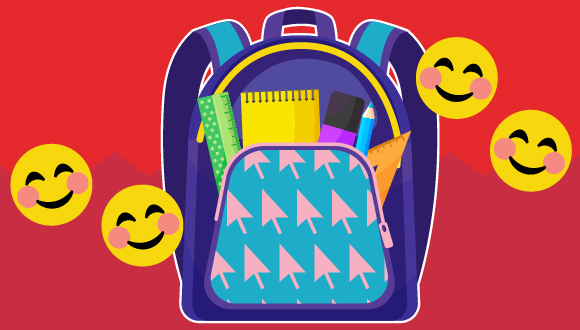Imagine doing your algebra homework without a calculator or taking notes in class without a notebook and pen. Hard to imagine, right?
Just as certain tools make learning easier and more productive, the tools in your cyber security backpack help make cyber security easier and more effective. Using the tools and best practices in your cyber security backpack is a great way to stay cyber safe as you go back to school.
Here’s what you need in your cyber security backpack:
Password manager (notebook)
Keeping your passwords secure is a crucial part of your cyber security. You should always use strong passphrases or passwords and avoid using the same password for multiple accounts. Since you will likely need to make new accounts as you start the school year, you should use a password manager to keep your passwords safe and organized.
Think of a password manager like your notebook at school. You use it to write down important information, but also to keep that information organized in a secure location. Your password manager does just that, minus the pages of doodles.
Multi-factor authentication (lock)
Multi-factor authentication (MFA) creates an extra layer of protection for your online activity by requiring multiple authenticators for your accounts (such as a password and facial recognition). It’s a great and simple way to secure your personal information online. You should enable MFA for any accounts and devices that allow it.
Imagine MFA as the lock on your locker. Make that two locks on your locker. Even if someone had a key to one lock (e.g., stolen your password), they won’t be able to get though the second lock. This keeps your stuff safe and lets people know that you take security seriously.
Automatic updates (agenda)
You may be updating your software to keep it running at its fastest speeds, but did you know that software updates also protect your devices? Making sure you have the latest updates installed can fix bugs or vulnerabilities in a device or software’s security. A great tip is to turn on automatic updates wherever you can. This will install updates as soon as they become available.
You can think of updates like your agenda. If you’re not updating your agenda consistently with your assignments and appointments, you won’t be running at top performance. While we don’t have a way to update your agenda automatically, you can and should do it for your software!
Stay alert for scams (glasses)
One of the most important parts of staying cyber safe is knowing the signs of scams, like phishing and watching out for them. As you head back to school, you might be meeting new people or joining different academic groups or clubs. Make sure to always verify unknown contacts. If any links or emails you receive seem suspicious, take the extra time to confirm whether they are legitimate before clicking on them.
When you’re active online, you should be wearing your cyber safe specs. Look at everything with cyber security in mind and stay alert for suspicious activity. This also applies to sharing personal information and downloading apps or software.
Conclusion
Making cyber security a priority in your life takes effort, but there are tools that can help you. Your cyber security backpack has some of the most important items to keep you safe: a password manager, MFA, automatic updates and your cyber safe specs. These tools will make sure you’re staying cyber safe as you go back to school.
